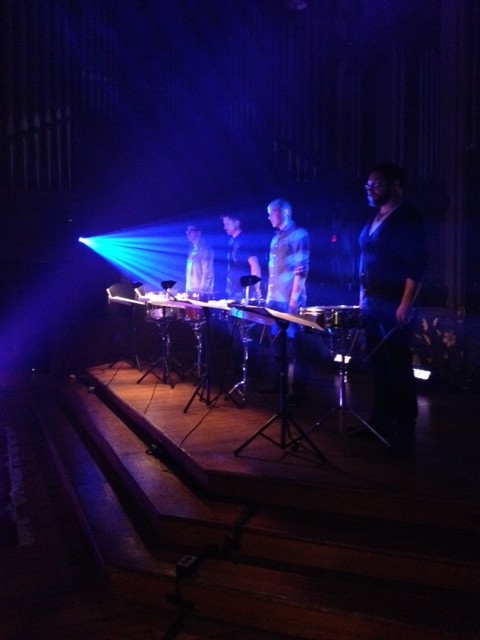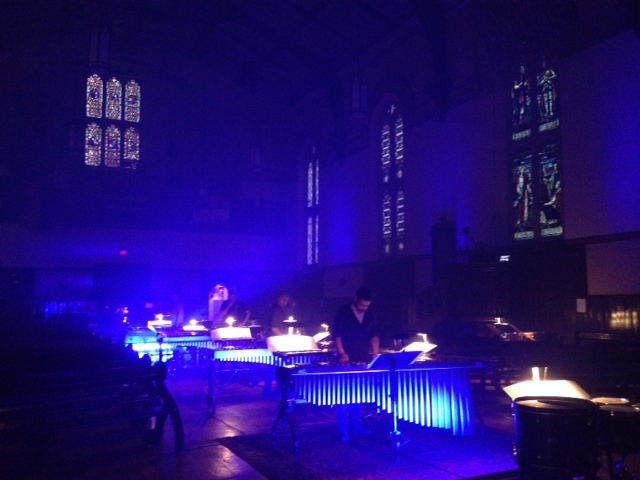
The most strange and sacred moment of TorQ’s May 9 performance of Strange and Sacred Noise was the start of the fifth movement: four marimbas stood in the central aisle of the Church of the Holy Trinity in Toronto. Jamie Drake, Adam Campbell, Daniel Morphy, and Richard Burrows waited, mallets in hand, to begin “clusters on a quadrilateral grid.” Thus far, John Luther Adams’ full-length concert work had focused on snare drums, tomtoms, sirens, tamtams. What would he do with the more conventional sound explorations that keyboard percussion seems to suggest? Would there be melody and harmony – a tune perhaps? Would we abandon the liminal world where music blurs the boundaries of noise, where sound simply as sound becomes an enveloping, body-saturating experience? Then suddenly, the quartet began to play: soft, rolled chords – one of the marimba’s signature sounds – but here in a cluster that seemed to defy all harmonic implication, instead opening a vast sense of echoing space. One could hear, see, taste, feel the huge arctic sweep of snow, stone, ice… cold that sings in the ear. The church and the city fell away to reveal – in sound – the natural world.
As the winner of the 2014 Pulitzer Prize for Music, Adams has received the public recognition due to “one of the most original musical thinkers of the new century” (Alex Ross, The New Yorker). Nonetheless, this was the Canadian premiere of Strange and Sacred Noise (1991-1997), whose six movements each explore a “set” of instruments (four snare drums, four tamtams, etc.) and their sonic possibilities at all extremes. In the second movement (“solitary and time-breaking waves”) the tamtams played in each corner of the nave swelled in their shimmering, crackling sheen to overwhelm all conventional listening, sweeping us past ear-wincing discomfort as the sound kept unfurling, revealing layer upon layer of timbre: much as sunlight can be pretty and then blinding, both gentle warmth and all-consuming fire. In “velocities crossing in phase space” (movement III) the surround-sound placement of the drums and tomtoms allowed each slowing, thunderous voice to speak distinctly, while the wooden pews shook with the gathering vibrations. The very earth seemed to shift, to slow and shudder.

TorQ’s presentation was the most dramatic of their 2013-2014 season, with the instruments placed around the church for surround-sound opportunities complemented by Oz Weaver’s light design. Stage smoke-filled the nave, distancing the quartet from their more usual laid-back audience rapport, allowing the audience to focus on the sound more than the personalities of the performers. This piece demands great endurance, physical strength, tight ensemble work, and profound understanding of this strange territory of sound, space, music, and noise. “This is a work that I’ve been thinking about – and wanting to play – for almost eight years now,” says TorQ’s Jamie Drake. “When I first encountered Adams’ music, I was struck (as many people are, I think) by his ideas of music representing place, or music as its own place. I also loved the idea that this is more than a ‘standard’ concert piece: the sheer length, and the material – music based on the ideas of ‘natural’ noise – make it seem almost more of an event or ritual than a musical performance.”
In his 2004 autobiography, Winter Sun: Composing the North, Adams writes that “this is not music as communication but as communion. My touchstone throughout was a deepening faith in the power of noise as a vehicle of transformation and revelation.” Adams’ understanding that the six movements are “places for listening, places in which to experience the elemental mystery of noise” was revealed by both the immaculate playing and the refined musicianship for which TorQ is known, each movement performed in a different spatial arrangement that built a visual as well as a sonic identity, as sound encountered the listening bodies from new directions. Drawing on his experience in theatre, Drake says he “saw this as a chance to bring a little bit of that world into what we do – to stage it with lighting, and in such a way that it was a whole experience for the audience, visually, aurally and emotionally.” Carefully selected audio clips of Adams’ own voice, as he reflected on the piece and his understanding of music and art, linked the movements and gave the piece context, although I would have preferred these as projections of text rather than recordings; the shift from live exploration of timbre to recorded speech did jar the ear, pulling it out of the alien sound world opening around it. While so many multimedia presentations are designed to distract, glossing over weak material or sloppy performance skill, here the lighting, the placement of the instruments, the setting in the church – even the smoke – came together organically while making strange all aspects of the experience, as the music opened new strange territory to the ear.
I’ve admired TorQ’s work since 2008, when they were in residence at the University of Toronto. I’ve found consistent excellence, both in musical skill and in a creative curiosity that draws together inventive programming, unusual performance spaces, and a frank, laid-back audience-friendly approach in which they introduce pieces, give updates about their future projects, introduce intriguing instruments etc. (although they wisely set this aside here to preserve the highly charged atmosphere of this dramatic work). Percussion concerts are a feast: so many different sounds, and a lot of visual fun too, since so many of the instruments are new to the non-percussionist. I often go with my father, a non-musician who loves the variety of TorQ’s percussion palette, and who likes watching how things work as much as hearing the result. Drake reveals: “We’ve actually played just the first movement a few times before – once on a concert in Toronto a few years ago, and every so often on various tours. We are constantly surprised by how much people like the piece. In some ways it’s difficult to listen to – the dynamics tend to the very extreme and the sounds can be very static in their own way – but even audience members who had zero music training or academic understanding of the music found it a very visceral, exciting piece. That’s when we decided to go ahead and program the whole piece.”
I note an increasing ambition in TorQ’s programming: their November 2013 concert of original arrangements of the Sonatas and Interludes of John Cage was a revelation, bringing out subtleties in these pieces that their forbidding surfaces can hide, with a playful, beautiful sound palette Cage’s prepared piano timbres invite. The arrangements themselves, and the sensitive, compassionate performance, drew on the same blend of originality, meticulous musicianship, and gracious humility that are bringing the quartet an increasing profile in Canada’s musical community. 2014-2015 will see their debut as featured soloists with the TSO, and in August 2014 they will present another Adams’ masterpiece, Inuksuit, as the conclusion of their summer seminar in association with Stratford Summer Music. This growing breadth shows a quiet sureness of vision and skill, and in Strange and Sacred Noise that confidence, energy, and subtlety shone darkly in a powerful and theatrical performance of a work that stands outside of trends or time. They may be young men, but they have old souls.
Cecilia Livingston is a composer who lives and works in Toronto.



